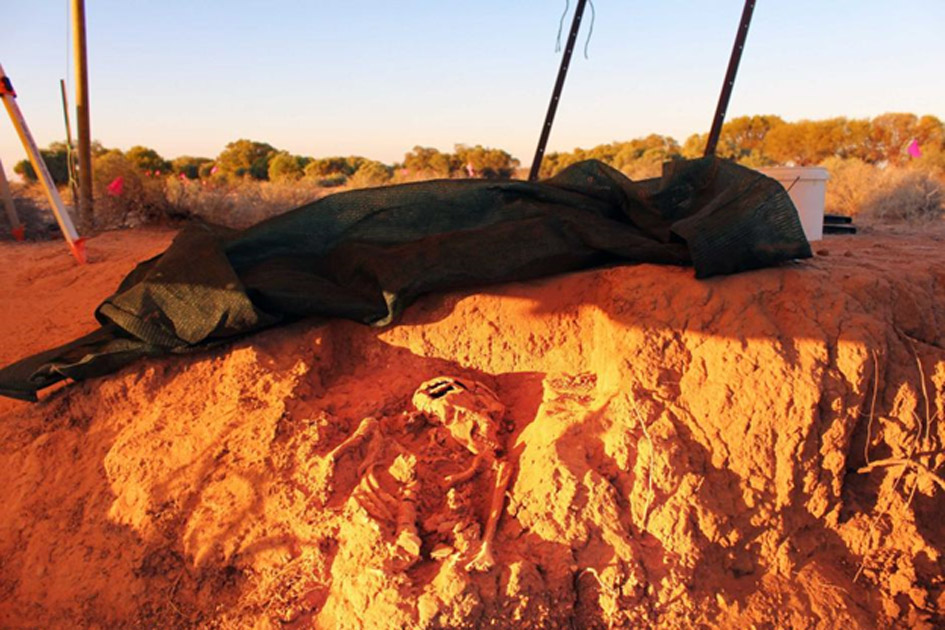Remote Australian Archaeological Site Provides More Evidence to Refute Traditional Theory of Entirely Nomadic Aborigines
Were the Australian Aborigines of years ago really hunter-gatherers, or did some have settled lives in villages with agriculture and architectural features? Some archaeologists are exploring this new avenue with Aboriginal researchers at a large site in Queensland’s Channel Country.
“There is generally an idea that Australia was a continent of hunter gatherers, but what we see in this landscape is extensive evidence for seed-grinding and processing,” Michael Westaway of Griffith University told ABC Australia. “We see these large site complexes that almost look like villages. If it does turn out to be something like that, well then, that really changes our entire perspective of the Aboriginal lifestyle, prior to the arrival of Europeans.”
Outback Discoveries
The researchers are examining the partial skeleton of what they think was a young man and have sent up drones to examine the landscape for evidence of architectural features. They’ve seen stone circles so far. They hope the skeletal remains can give them some idea of what people were doing in this area before Europeans began arriving in Australia in 1788.
Mithaka elder George Gorringe said he hopes the drone will help them work out how his ancestors used these sites. He told ABC:
‘My theory at this stage is I think it is some type of ceremonial ground. We're not sure if it's men or women, but we'll find out through the research.’
Dr. Westaway said the scale and complexity of the archaeology is “really extraordinary.” The sites cover several square kilometers, he said.

This stone circle is one of several archaeological features over quite a few square kilometers in Queensland’s Channel Country. (ABC photo)
The Nomad Belief
In 2007, The Guardian featured a story that research by Paul Memmot of the University of Queensland showed Australia’s natives had sophisticated architecture in their dwellings, which were in various styles depending on climate.
Dr. Memmot’s research refuted the prevailing theory that Aborigines were completely nomadic. The belief by early European settlers was used to claim lands of the natives for their own, because they said the land belonged to no one, The Guardian said.
During good weather, indigenous Australians were more mobile. It was during these times that the British observed them more, which led them to assume that the natives were nomads. This was perhaps a weak argument used to justify their claims to land ownership of much of the continent.
Mr. Gorringe said the more recent discoveries of 2017 are big news that needs to be passed down to his people so it’s not lost. This way it won’t be word of mouth, which is ineffective because there aren’t enough elders left. “Most of the old people are gone and they haven't passed that down, so if we can do this now, we're going to save the next generation the trouble we've had over the years.”

Analysis of the skeleton can help archaeologists determine whether Aborigines migrated and what they ate. (ABC photo)
Burial Analysis
If this skeleton was buried by Mr. Gorringe’s ancestors and the person didn’t die in the wild with no one to bury him, this illustrates burial practices have changed through the ages. Now, some Aborigines cover the body with plants and expose it to the elements on a raised platform for months until it consists of just bones.
The blog SevenPonds explains the second part of the funerary practice:
The secondary burial consists of the ceremonial aspect of the funeral. When nothing but bones are left, family and friends will scatter them in a variety of ways. Whether they wrap the bones in a hand-knitted fabric and place them in a cave for eventual disintegration or place them in a naturally hollowed out log, the process is environmentally sound. The respect for nature as well as the loved one who passed away leads me to think there are still many things we can learn from this ancient culture.
Working with the Aboriginal and archaeological researchers are former soldiers called Cameleers of Australia’s military. They are doing much of the heavy work and are benefiting by getting a sense of self-worth, which they sometimes lack after discharge from the military, ABC says.
Top image: Archaeologists hope to learn more about pre-contact Aboriginal Australians from this skeleton and from architectural features in the landscape where it was found. (ABC photo)
By Mark Miller



















